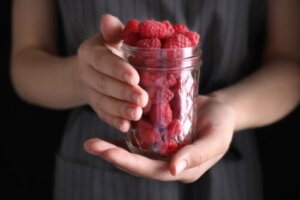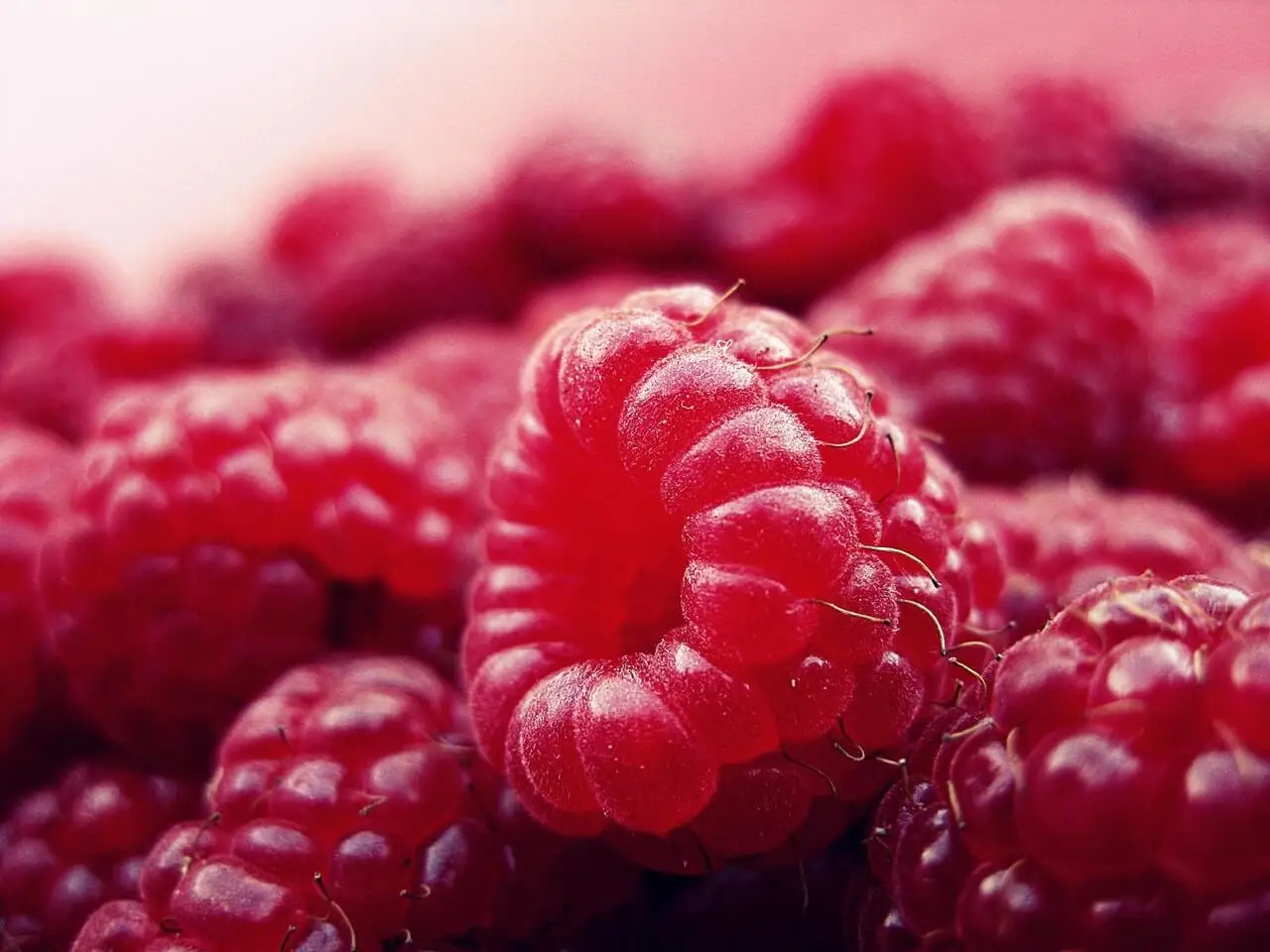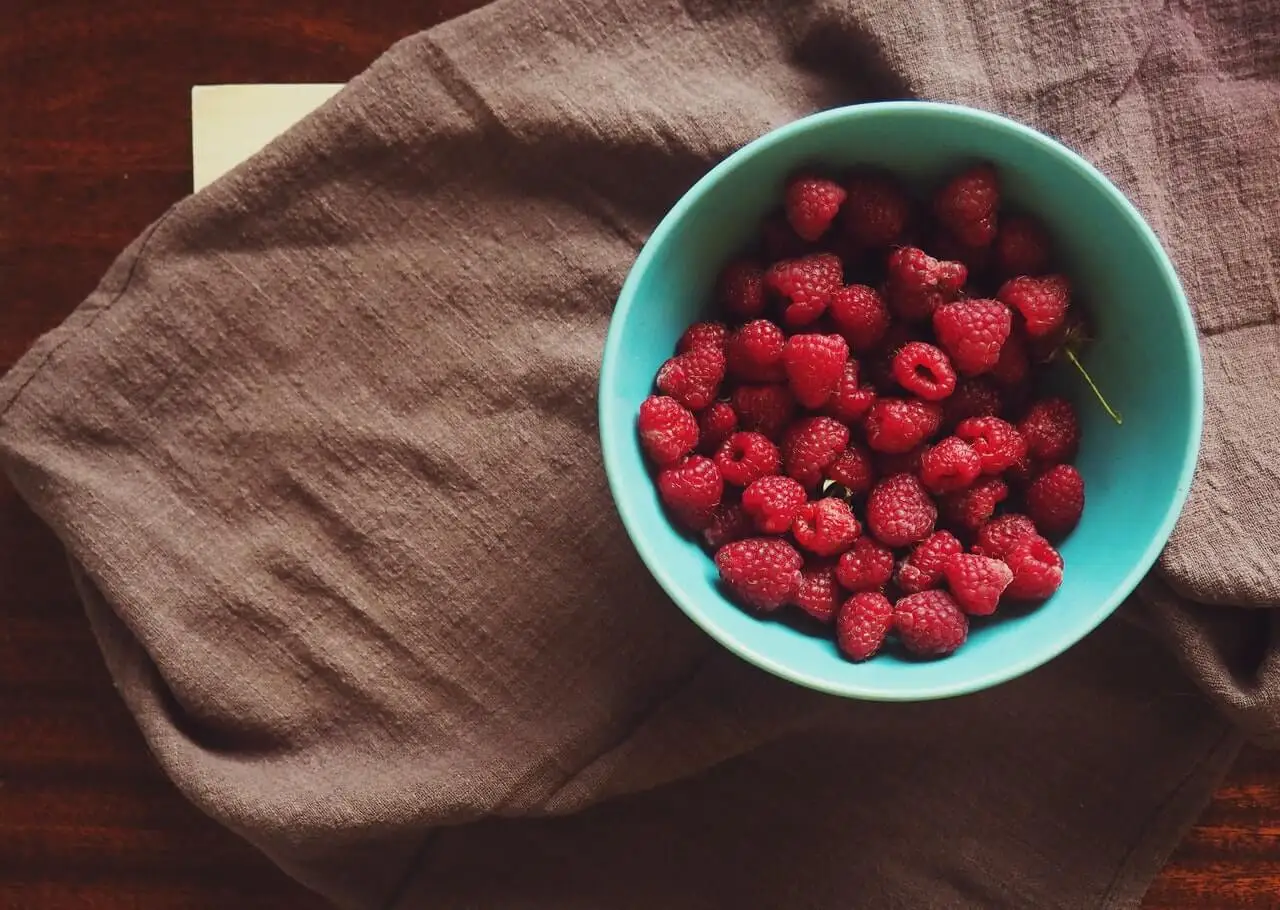What Are The Benefits of Raspberries?


Written and verified by the nutritionist Maria Patricia Pinero Corredor
Fruits and vegetables has always been part of healthy diets, since they protect against certain diseases generated by oxidative stress. Raspberries (Rubus spp.) are an example of this type of food, as they provide antioxidants. In fact, there are many benefits of raspberries.
Raspberries, in addition to being popular in sensory terms, are also considered functional foods or nutraceuticals. They contain bioactive compounds, such as anthocyanins, which have proven health benefits,
The characteristics of raspberries
The raspberry of any variety is the fruit of a shrub that belongs to the Rosaceae family. It usually grows in European forests, where it’s native. It seems to have originated in Greece and from there passed from other countries to North America.
The most common varieties are red (Rubus idaeus), typical of Europe, and red and black in North America, such as black raspberry (Rubus occidentalis), wild raspberry (Rubus strigosus), and purple raspberry (Rubus neglectus).
Its shape is round or conical. The skin is velvety and covered with fine hairs. It’s a fruit that is composed of many berries grouped in miniature, each one containing a single seed.
We think you may also enjoy reading this article: How to Grow Blackberries and What Are Their Benefits?
Nutritional components
The following is a list of nutrients in a normal serving (1 cup or 144 grams of raw raspberries) of any variety:
- Energy: 75 calories
- Carbohydrates: 18 grams
- Fiber: 7.6 grams
- Potassium: 282 milligrams
- Vitamin C: 30 milligrams
According to the indicated values, raspberries can be included in weight loss diets, since a normal portion only provides 75 calories. The energy in raspberries comes from fructose and glucose, which are absorbed very quickly.
The potassium value is similar to that of lemon juice, sliced mango, and melon pulp. Potassium helps with muscle contraction and heart rate.
Raspberries have a fiber content above other fruits. They’re consumed whole, which serves to take advantage of their soluble and insoluble fiber and prevent constipation.
Vitamin C is found in moderate values, so it’s recommended to eat it fresh to make the best use of it. If you’re going to prepare raspberry juice, make sure to do it quickly so that the vitamin C doesn’t oxidize.

The bioactive components in raspberries
Several experts agree that raspberries, blackberries, and berries in general contain several types of antioxidant polyphenols, such as phenolic acids, flavonoids, and anthocyanins, and others such as resveratrol and ellagic acid. For this reason, Clark and Finn recommend red fruits within the health improvement program.
Other researchers published that anthocyanin values in raspberries and other berries can be as high as 223 milligrams per 100 grams of fruit. Polyphenols range from 657 to 2611 milligrams in 100 grams of dried fruit.
Vitamin C was found to range from 14 to 103 milligrams per 100 grams of fresh raspberries. These values support the high antioxidant capacity.
The benefits of raspberries
It’s clear that most of the benefits of raspberries are due to the presence of antioxidants that protect the body when consumed. But let’s take a look at a few more benefits.
1. They can improve certain intestinal problems
A diet low in fiber is associated with intestinal problems such as constipation and bloating. In addition, a BMJ article published that when fiber is not enough in the diet, it can increase the risk of heart disease.
One cup of fresh raspberries, despite their small size, can provide up to 8 grams of fiber. Raspberries are the highest fiber berry compared to others, such as blackberries, strawberries, and blueberries.
When you eat the required amount of fiber you lower cholesterol, control blood sugar, promote bowel movement, and keep you feeling full. Some types of fiber act as food for intestinal bacteria.
2. They can fight oxidative stress
Free radicals are molecules that are formed from biological reactions in the body. They’re very reactive, so they oxidize and damage whatever is around them. This effect leads to degenerative diseases and aging. To live a healthier life, a balance between the formation of free radicals and the antioxidants that can neutralize them is necessary.
The darker the raspberry, the greater the variety of anthocyanins and cyanidins with antioxidant capacity. An antioxidant value 3.5 times higher than vitamin E is reported. Not to mention the vitamin C content, which also has these properties.
The journal Nutrition Research reported that 300 grams (10 ounces) of berries are able to protect DNA against free radical damage. Likewise, another study revealed that eating 1/2 kilo of berry pulp daily for a month reduces a prooxidant marker by 38%.
3. They decrease the risk of heart disease
When LDL or bad cholesterol values rise in the blood, it becomes a risk factor for the heart. Phenolic compounds in raspberries and other berries may protect the heart by inhibiting LDL oxidation.
Research explains that this occurs because phenols block free radicals (in rat assays). A similar effect has also been observed in human cells.
Moreover, it appears that anthocyanins suppress a protein known as MCP-1. This protein induces the formation of lipid plaques in arterial walls.
4. They can help prevent neurodegenerative conditions
Eating some delicious and juicy raspberries of different colors can improve brain health and help prevent the lack of memory, common during aging. From the Human Nutrition Research Center on Aging, it was disseminated that antioxidants in berries, such as raspberries, can prevent disruption in brain cell communication.
In addition, these fruits also help reduce brain inflammation that is triggered by motor problems typical of aging and cognitive functions. A study in rats revealed that anthocyanins are beneficial in preventing Alzheimer’s disease.
5. They may improve insulin and blood sugar levels
Diets with a high glycemic response may be associated with an increased risk of obesity and type 2 diabetes. However, polyphenols may improve these responses and maintain blood sugar control.
The British Journal of Nutrition found that by eating raspberries and other berries with bread, participants improved insulin response. In obese people with insulin resistance tests have also been conducted. For 6 weeks, they drank a purple berry smoothie 2 times a day. An improvement in insulin sensitivity was found.
6. They’re anti-inflammatory
Inflammation is a sign of the body’s defense against infection or injury. Fortunately, berries have anti-inflammatory properties. Chronic inflammation is a precursor to diabetes, obesity, and heart disease.
Some scholars claim that polyphenolic compounds, especially anthocyanins, have anti-inflammatory activity in animals and humans. This anti-inflammatory power of berries is effective both in people with normal weight and in those with obesity and overweight. This is shown by a study.
7. Raspberries could be beneficial for the skin
Free radicals tend to cause skin damage that accelerates aging. However, specialists say that raspberries can help reduce wrinkles.
Laboratory and animal tests indicate that the ellagic acid in the berries is the main antioxidant for the skin. It acts as a blocker of the enzymes that break down collagen.
Do you know what collagen is? It’s a protein that gives structure to the skin and allows it to stretch and stay firm. If collagen is damaged, then wrinkles appear.
Like this article? You may also like to read: What Are Goji Berries and Why Are They Good For You?
8. They can help protect against cancer
Epidemiological evidence suggests that more than 20% of cancer cases can be prevented with a diet containing 400 to 800 grams of various vegetables and fruits per day. Phytochemicals in berries, such as raspberries, can modulate cancer initiation, promotion, and progression.
Some cancer researchers have worked on anthocyanins, resveratrol, and ellagic acid. They found that these phytochemicals induce antioxidation, detoxification, cell death, and antiproliferation of malignant cells in experimental animals.
Despite these results, the science is still lacking concrete results. Some animal trials cannot be safely extrapolated to humans and others conducted on patients may be contradictory.

Possible contraindications of raspberries
Although raspberries are delicious, nutritious, and beneficial, some precautions should be taken when consuming them, such as the following:
- Red berries appear on the list of allergenic foods.
- They’re forbidden in cases of duodenal and stomach ulcers, gastritis, nasal polyps, nephritis, gout, asthma, and polyarthritis.
- They should not be part of the diet of people who tend to form clots or take anticoagulants.
- Pregnant women can’t eat more than 3 raspberries a day, as they can cause allergies.
Raspberries should be part of healthy diet programs. Of course, combined with other vegetables and fruits.
A diet with fresh raspberries, frozen, in ice cream, or with cream, shakes, and smoothies, among other preparations, will allow a healthier life through the antioxidant and anti-inflammatory benefits of these berries.
All cited sources were thoroughly reviewed by our team to ensure their quality, reliability, currency, and validity. The bibliography of this article was considered reliable and of academic or scientific accuracy.
- Frambuesa. Raspberry Rubus idaeus L. Disponible en: https://www.mapa.gob.es/es/ministerio/servicios/informacion/frambuesa_tcm30-102818.pdf
- Susan E. Gebhardt and Robin G.Thomas. United States Department of Agriculture (USDA). Home and Garden Bulletin Number 72. 2002. Disponible en: https://naldc.nal.usda.gov/download/CAT11131126/PDF
- Potasio en la dieta. MedlinePlus. Disponible en: https://medlineplus.gov/spanish/potassium.html
- Reyes-Carmona J., Yousef G.G., Martinez-Peniche R.A., Lila M.A. (2005): Antioxidant capacity of fruit extracts of blackberry (Rubus sp.) produced in different climatic regions. Journal of Food Science, 70: 497–503.
- Clark J.R., Finn C.E. (2011): Blackberry breeding and genetics. Fruit, Vegetable and Cereal Science and Biotechnology, 5: 27–43.
- Pantelidis, G., Vasilakakis, M.D., Manganaris, G.A., & Diamantidis, G. (2007). Antioxidant capacity, phenol, anthocyanin and ascorbic acid contents in raspberries, blackberries, red currants, gooseberries and Cornelian cherries. Food Chemistry, 102, 777-783.
- Wang, S.Y. “Antioxidant capacity and phenolic content of berry fruits as affected by genotype, preharvest conditions, maturity, and postharvest handling”@eng. Boca Raton : CRC Press, c2007. Food science and technology. 2013. 147-186.
- Wang, H.; Cao, G.; Prior, R. L. Oxygen radical absorbing capacity of anthocyanins. J. Agric. Food Chem. 1997, 45, 304–309.
- Giusti, M. M.; Jing, P. Natural pigments of berries: functionality and application. In Berry Fruit. Value-Added Products for Health Promotion, 1st ed.; Zhao, Y., Ed.; CRC: Boca Raton, FL, 2007; Vol. 1, pp 105146
- Shahidi, F.; Naczk, M. Phenolics in Food and Nutraceuticals; CRC: Boca Raton, FL, 2004; Vol. 1, pp 558595.
- Garcia-Alonso, M.; Minihane, A. M.; Rimbach, G.; Rivas-Gonzalo, J. C.; de Pascual-Teresa, S. Red wine anthocyanins are rapidly absorbed in humans and affect monocyte chemoattractant protein 1 levels and antioxidant capacity of plasma. J. Nutr. Biochem. 2009, 20, 521–529.
- Freedman, J. E.; Parker, C.; Li, L.; Perlman, J. A.; Frei, B.; Ivanov, V.; Deak, L. R.; Iafrati, M. D.; Folts, J. D. Select flavonoids and whole juice from purple grapes inhibit platelet function and enhance nitric oxide release. Circulation 2001, 103, 2792–2798
- Marshall G. Miller and Barbara Shukitt-HaleJ. Berry Fruit Enhances Beneficial Signaling in the Brain Agric. Food Chem. 2012, 60, 23, 5709–5715. Disponible en: https://doi.org/10.1021/jf2036033
- Del Bo’, C., Riso, P., Campolo, J., Møller, P., Loft, S.H., Klimis-Zacas, D.J., Brambilla, A., Rizzolo, A., & Porrini, M. (2013). A single portion of blueberry (Vaccinium corymbosum L) improves protection against DNA damage but not vascular function in healthy male volunteers. Nutrition research, 33 3, 220-7 .
- Białasiewicz, P., Prymont-Przymińska, A., Zwolińska, A., Sarniak, A., Włodarczyk, A., Król, M., Glušac, J., Nowak, P.J., Markowski, J., Rutkowski, K.P., & Nowak, D. (2014). Addition of Strawberries to the Usual Diet Decreases Resting Chemiluminescence of Fasting Blood in Healthy Subjects—Possible Health-Promoting Effect of These Fruits Consumption. Journal of the American College of Nutrition, 33, 274 – 287.
- Törrönen, R., Sarkkinen, E.S., Tapola, N.S., Hautaniemi, E.J., Kilpi, K., & Niskanen, L. (2009). Berries modify the postprandial plasma glucose response to sucrose in healthy subjects. British Journal of Nutrition, 103, 1094 – 1097.
- Stull AJ, Cash KC, Johnson WD, Champagne CM, Cefalu WT. Bioactives in blueberries improve insulin sensitivity in obese, insulin-resistant men and women. J Nutr. 2010;140(10):1764-1768. doi:10.3945/jn.110.125336
- Shukitt-Hale, B.; Cheng, V.; Joseph, J. A. Effects of blackberries on motor and cognitive function in aged rats. Nutr. Neurosci. 2009, 12, 135–140
- Marshall G. Miller, Nopporn Thangthaeng, Grant A. Rutledge, Tammy M. Scott, Barbara Shukitt-Hale. Dietary strawberry improves cognition in a randomised, double-blind, placebo-controlled trial in older adults. British Journal of Nutrition 2021, 126 (2) , 253-263. https://doi.org/10.1017/S0007114521000222
- Shama V. Joseph, Indika Edirisinghe, and Britt M. Burton-Freeman. Journal of Agricultural and Food Chemistry 2014 62 (18), 3886-3903. DOI: 10.1021/jf4044056
- Edirisinghe, I., Banaszewski, K., Cappozzo, J.C., Sandhya, K., Ellis, C.L., Tadapaneni, R.K., Kappagoda, C.T., & Burton-Freeman, B. (2011). Strawberry anthocyanin and its association with postprandial inflammation and insulin. The British journal of nutrition, 106 6, 913-22 .
- Bae, J., Choi, J., Kang, S.W., Lee, Y., Park, J., & Kang, Y. (2010). Dietary compound ellagic acid alleviates skin wrinkle and inflammation induced by UV‐B irradiation. Experimental Dermatology, 19.
- Aiyer HS, Vadhanam MV, Stoyanova R, Caprio GD, Clapper ML, Gupta RC. Dietary berries and ellagic acid prevent oxidative DNA damage and modulate expression of DNA repair genes. Int J Mol Sci. 2008;9(3):327-341. doi:10.3390/ijms9030327
- Lydia Kaume, Luke R. Howard, and Latha Devareddy. Journal of Agricultural and Food Chemistry 2012 60 (23), 5716-5727. DOI: 10.1021/jf203318p
- Duthie, S.J. (2007). Berry phytochemicals, genomic stability and cancer: evidence for chemoprotection at several stages in the carcinogenic process. Molecular nutrition & food research, 51 6, 665-74 .
This text is provided for informational purposes only and does not replace consultation with a professional. If in doubt, consult your specialist.








